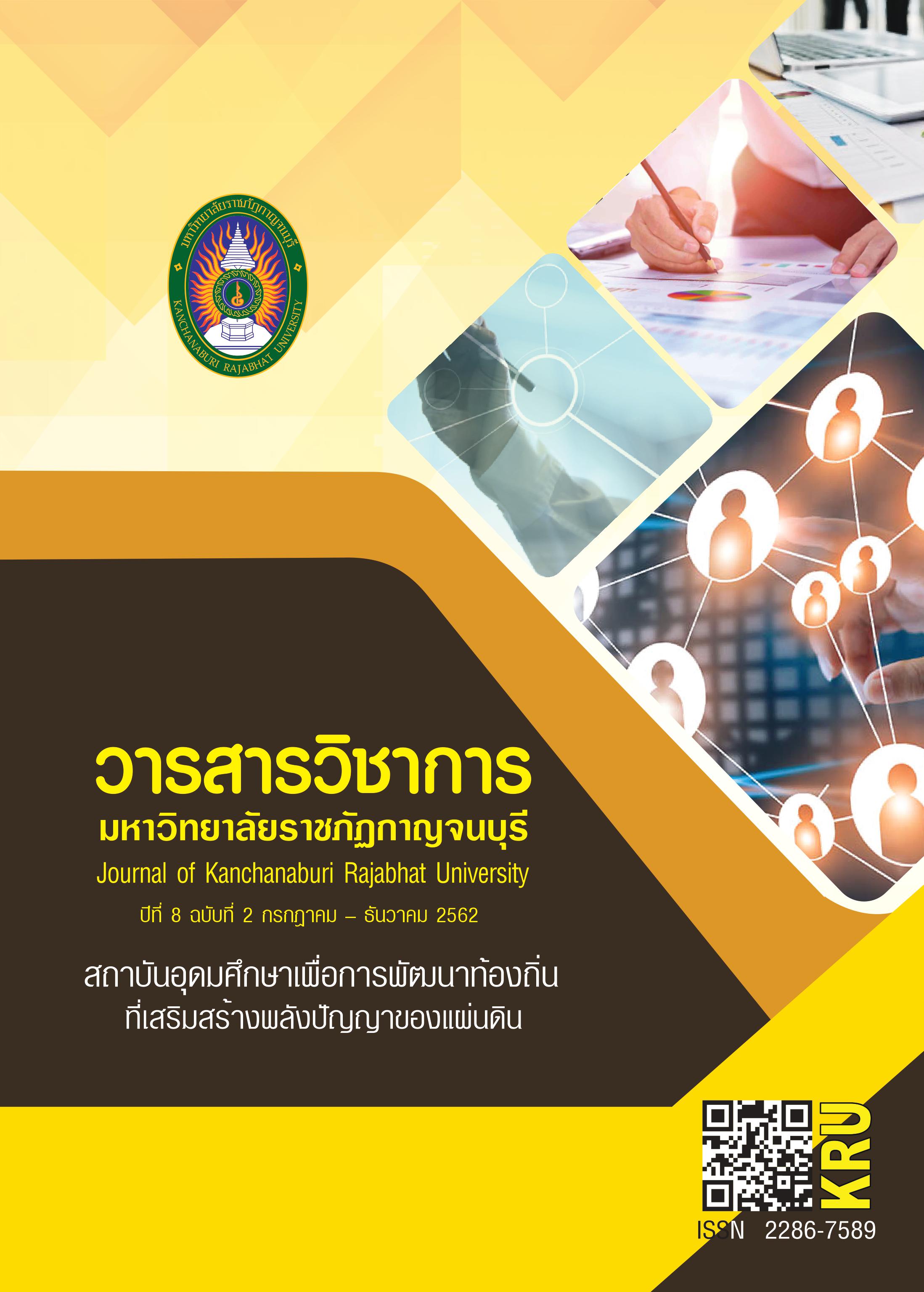SUPERVISION PROCESS BY APPLYING DEMING CIRCLE INTO PROFESSIONAL LEARNING COMMUNITY TO DEVELOP MATHEMATICS LEARNING ACHIEVEMENT FOR FEATURED PRIMARY SCHOOL BEING TAUGHT BY INDIAN STYLE SPEED CALCULATOR METHOD (VEDIC MATHEMATICS) UNDER KANCHANABURI PRIMARY EDUCATIONAL SERVICE AREA OFFICE TWO
Main Article Content
Abstract
The purposes of this research were: 1) to study mathematics learning achievement of featured primary school being taught by Indian style speed calculator (Vedic Mathematics) 2) to compare learning achievement of featured primary school before and after being taught by Indian style speed calculator (Vedic Mathematics) 3) to investigate the opinions of teachers at featured primary school towards supervision process by applying Deming circle into professional learning community and 4) to investigate the opinions of students at featured primary school towards being taught by Indian style speed calculator (Vedic Mathematics)
This research was an experimental type being taught by one group pretest-posttest design. It was divided into 3 groups; 1) Instructors provided instructional process throgh Indian style speed calculator (Vedic Mathematics) from five schools; Anubanwatlukkaeprachachanutis, Watkhosapairang, Watdonchaem, Watbenyapad and Watdonsalab. 2) two mathematics teachers of featured school at Bantoonpratoon Primary School who taught fourth and fifth grade 3) students from featured school at Bantoonpratoon Primary School as of 31 students from fourth grade for 20 students and 11 students of fifth grade.
The instruments used for gathering data were: 1) structured interview sheet 2) learning achievement tests for fourth grade and fifth grade used as a pretest and posttest and 3) questionnaire used for asking students’ opinions towards the instructions of Indian style speed calculator (Vedic Mathematics). The mean, the standard deviation and percentage were used for analyzing the data in order to study and to compare. The content analysis was used for diagnosing the data in order to study the teachers’ opinions at featured primary school towards supervision process by applying Deming circle into professional learning community. In addition, the mean and the standard deviation of items were used to evaluate the students’ opinions at featured primary school towards the instructions of Indian style speed calculator (Vedic Mathematics).
The results of the study were:
- The learning achievement of featured primary school at fourth grade and at fifth grade in terms of amount content and process, measure, geometry, algebra, data analysis and probability was different and better after being taught.
- The learning achievement of featured primary school at fourth grade and fifth grade after being taught by Indian style speed calculator (Vedic Mathematics) was different by the total of valued average higher than before being taught.
- The opinions of mathematics teachers at featured primary school towards supervision process by applying Deming circle into professional learning community at implementation of supervision, supervising atmosphere and learning usefulness as the total of high level.
- The opinions of fourth grade and fifth grade students towards being taught by Indian style speed calculator (Vedic Mathematics) with the total of the highest level for both learning usefulness and learning activity procedures while having the total of high level for the learning atmosphere.
Article Details
References
นิจวรรณ วีรวัฒโนดม และนงนภัทร รุ่งเนย. (2558). การดำเนินงานประกันคุณภาพการศึกษาตามวงจรเดมมิ่ง เพื่อผลลัพธ์ตามเกณฑ์การประกันคุณภาพการศึกษา. วารสารวิทยาลัยพยาบาลพระปกเกล้า จันทบุรี, 26(1), 86.
เรวณี ชัยเชาวรัตน์. (2556). กระบวนการเสริมสร้างความสามารถในการออกแบบการเรียนการสอนของนักศึกษาปฏิบัติการวิชาชีพครูตามแนวคิดชุมชนการเรียนรู้ทางวิชาชีพ: การวิจัยกรณีศึกษา. วิทยานิพนธ์ครุศาสตรดุษฎีบัณฑิต สาขาหลักสูตรและการสอน จุฬาลงกรณ์มหาวิทยาลัย.
วัชรา เล่าเรียนดี. (2548). การนิเทศการสอน. นครปฐม: มหาวิทยาลัยศิลปากร.
วิกิพีเดีย. (2561). PDCA. ค้นเมื่อ เมษายน 23, 2561, จาก https://th.wikipedia.org/wiki/PDCA.
วีรพล บดีรัฐ. (2543). PDCA วงจรสู่ความสำเร็จ. กรุงเทพฯ: ประชาชน.
วรลักษณ์ ชูกำเนิด และคณะ. (2557). รูปแบบชุมชนการเรียนรู้ทางวิชาชีพครูสู่การเรียนรู้ในศตวรรษที่ 21 บริบทโรงเรียนในประเทศไทย. วารสารหาดใหญ่วิชาการ, 12(2), 127-131.
สุภาภรณ์ ผู้ผึ้ง. (2558). กระบวนการและแนวทางในการพัฒนาโครงการครูพันธุ์บึง มหาวิทยาลัยราชภัฏหมู่บ้านจอมบึง. วิทยานิพนธ์ศิลปศาสตรมหาบัณฑิต สาขาวิชาการจัดการภาครัฐและภาคเอกชน มหาวิทยาลัยศิลปากร.
สำนักงานเขตพื้นที่การศึกษาประถมศึกษากาญจนบุรี เขต 2. (2560). รายงานการประเมินคุณภาพการศึกษาระดับเขตพื้นที่การศึกษา ข้อสอบมาตรฐานกลาง ปีการศึกษา 2559. กาญจนบุรี: เอกสารกลุ่มนิเทศ ลำดับที่ 3/2560.
สำนักงานคณะกรรมการการศึกษาแห่งชาติ. (2545). พระราชบัญญัติการศึกษาแห่งชาติ พ.ศ.2542 และที่แก้ไขเพิ่มเติม (ฉบับที่ 2) พ.ศ.2545. กรุงเทพฯ: พริกหวานกราฟฟิค.
สำนักงานเลขาธิการสภาการศึกษา. (2559). รายงานการวิจัยแนวโน้มภาพในอนาคตการศึกษาและ
การเรียนรู้ของไทยในปี พ.ศ.2573. นนทบุรี: 21 เซ็นจูรี่.
สำนักงานคณะกรรมการการศึกษาขั้นพื้นฐาน. (2560). เทคนิคการคิดเลขเร็วแบบอินเดีย (เวทคณิต). กรุงเทพฯ: สำนักงานคณะกรรมการการศึกษาขั้นพื้นฐาน.
อนุสรา สุวรรณวงศ์. (2559). กลยุทธ์การบริหารเพื่อเสริมสร้างชุมชนแห่งการเรียนรู้ทางวิชาชีพสำหรับครูโรงเรียนเอกชน. วิทยานิพนธ์ครุศาสตรดุษฎีบัณฑิต สาขาวิชาบริหารการศึกษา จุฬาลงกรณ์มหาวิทยาลัย.
อาภาภรณ์ นันทัชพรพงศ์ และคณะ. (2544). ผลการใช้แบบฝึกทักษะการคิดคำนวณตามแนวเวทคณิต เรื่อง การบวกและการลบ สำหรับนักเรียนชั้นประถมศึกษาปีที่ 1. กรุงเทพฯ: สำนักงานคณะกรรมการวิจัยแห่งชาติ.
Acheson, A. K., and Gall, D.M. (2003). Clinical supervision and teacher development preservice and inservice Applications. New Jersey: John Wiley & Sons.
DuFour, R. (2004). What is professional learning community?. Schools as learning communities, 8(61), 6-11.
Glickman, D. C. (1990). Supervision of instruction: A Developmental approach (2nd ed.). Massachusetts: Allyn and Bacon.
Herzberg, F. (1988). The Motivation of work. New York: John Wiley & Sons.
Hord, S. M., Roussin, J. L., and Sommers, W. A. (2010). Guiding professional learning communities: Inspiration, challenge, surprise, and meaning. California: Corwin.
McGregor, D. (1960). The Human side of enterprise. New York: McGraw–Hill.
Vescio, V., Ross, D., and Adams, A. (2008). A review of research on the impact of professional learning ommunities on teaching practice and student learning. Teaching and Teacher Education, 24(2), 80–91.

